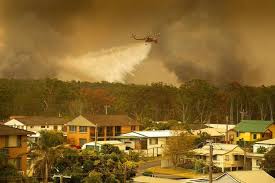Australian officials declared a state of emergency for the capital city of Canberra and surrounding regions on Friday, as soaring temperatures and strong winds threatened to propel a large bushfire beyond the control of firefighters.
Andrew Barr, Chief Minister for the Australian Capital Territory (ACT), said the decision to declare the first state of emergency since fatal wildfires in 2003 indicated the potential danger over the weekend.
Officials said an uncontrolled fire in the ACT’s south, on the doorstep of Canberra, had grown to 185 sq km, almost 8% of the territory’s land mass.
“This fire may become very unpredictable. It may become uncontrollable,” Barr told reporters in a televised briefing. “The combination of extreme heat, wind, and a dry landscape will place suburbs in Canberra’s south at risk.”
Australia’s federal parliament is located in Canberra, which is also home to several government and independent institutions as well as national museums. Four people died and almost 500 homes were destroyed in the 2003 Canberra fires.
The state of emergency declared on Friday will run for 72 hours, giving authorities greater powers to order evacuations, close roads and take control of private property.
Heatwave conditions are also expected to sweep through Victoria and New South Wales states over the weekend, where some 80 fires are burning.
In neighboring New Zealand, where smoke from the Australian blazes has turned glaciers brown, firefighters were battling to contain around 25 fires that spread rapidly to cover around 100 hectares on the South Island. Heatwave conditions were also forecast for much of the country over the weekend.
Australia has been battling bushfires across its east coast that have killed 33 people and an estimated 1 billion native animals since September. Around 2,500 homes have been destroyed as more than 11.7 million hectares (117,000 sq km) have been razed.
Key events on Friday in the bushfire crisis:
** There were 58 active fires in NSW state, 20 in Victoria and 22 in South Australia.
** Temperatures across NSW and Victoria states were forecast to reach 40 degrees Celsius (104 degree Fahrenheit) on Friday.
** The Australian Energy Market Operator, attempting to prevent supply shortages, urged people in Victoria to restrict energy use on Friday evening when demand is expected to peak because of unusually high humidity.
** Prime Minister Scott Morrison, who critics say has not done enough to address the impact of climate change, on Friday pledged funding for emissions reduction projects as part of a A$2 billion ($1.37 billion) package to increase gas supplies in NSW.
Reuters
 Lebanese Ministry of Information
Lebanese Ministry of Information


